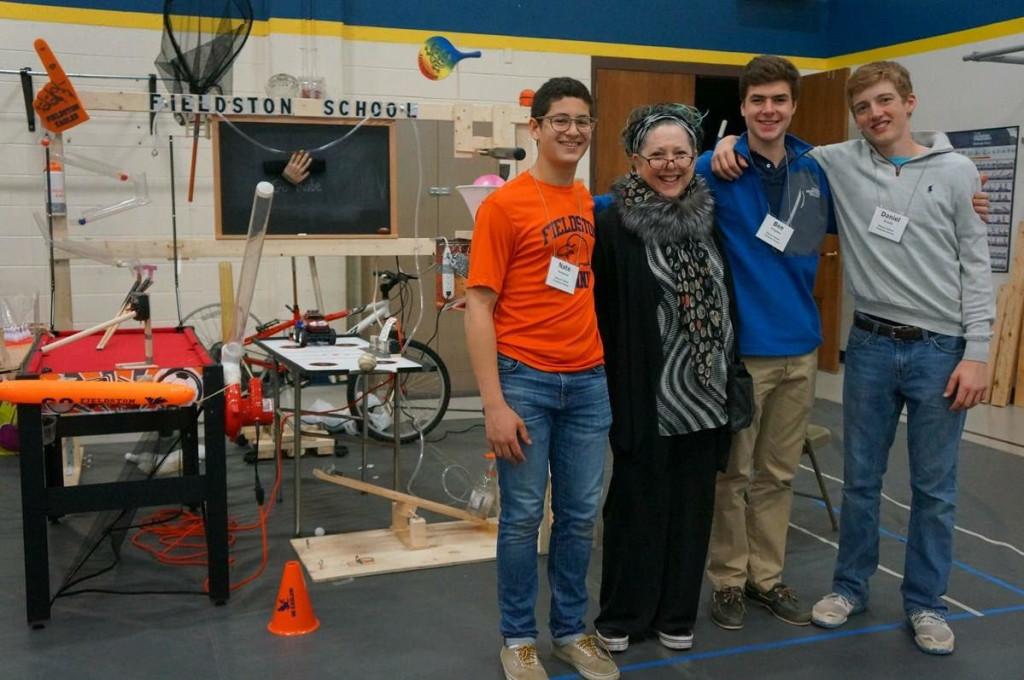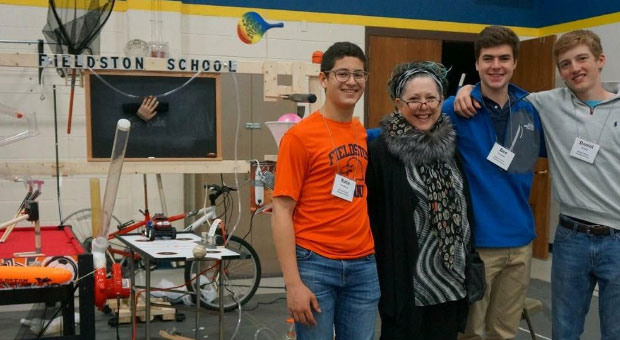
The Fieldston team poses in front of their machine with Jennifer George.
In early April, Nate Newhouse, Daniel Broadie and I participated in a national Rube Goldberg competition. A Rube Goldberg machine is a device that has 20 or more steps to perform a simple task. The task of this year’s competition was to erase a chalkboard. We first became interested in the competition in October when Dr. Church suggested to Nate, the leader of the Engineering Club, to compete in a regional Rube Goldberg competition as a fun and educational project for the club. As members of the engineering club, Daniel and I happily joined the project since we both enjoy a fun problem solving challenge. Little did we know, that this project would provide valuable lessons about hard work, out-of-the-box thinking and group cooperation.
The first step of the project was to to create the unit to erase the chalkboard and work our way back to the start of the machine. We created a unit with a vertical flexing arm that was attached to the pedal of bicycle. When the back wheel spun, the pedal moved and allowed the flexing arm to move up and down. On the top of the flexing arm was a horizontal piece of wood in which we placed magnets inside of the wood, which when pressed to the back side of a chalk board would attach to a eraser on the front side. However as a result of the busyness of Junior year, It took us until January to fully develop the first unit. With the regional competition only a few months away, we committed to working on the project every sunday at Fieldston. We would all drive up and meet Dr. Church to add different units of the project. By early February, we did not make as much progress as we would have liked. We had our first unit, and a few general ideas on how we could add more transitions.
By March, the morale of the group became increasingly low. We had essentially produced a machine with lots of ideas but limited results. The Sunday work session became more and more like a tedious job. Fortunately, we caught a lucky break when we found out that our regional competition was over Spring break. This allowed us to skip the regional round and go straight to the national competition in April. We decided as a group that to create a quality machine and enjoy ourselves in the process, we would have to refocus on the main reason that we started the project: that we all enjoy building and problem solving. We decided right then and there that to create a great machine, we would have to create steps that exhibited our creative ability. After we regained our original motivation, the development became seamless. We added elements such a mini pool table, a ping pong ball launcher, a catapult, a coke/mentos reaction and even balloon popping contraption. We finally had a consonance of creative ideas, hard work, group cooperation.
With two weeks until the competition, we had a finely tuned and consistently functioning machine. A week later we shipped our machine to the site of the competition in Pewaukee, Wisconsin. Unfortunately, in Pewaukee our machine did not perform consistently and we did not win the competition. We did, however, win the risk award for our creativity. Despite not winning the competition, we were proud of our machine and the progress we made. I would characterize the project as a success in that we all worked hard, exhibited team work and persevered through adversity. We all intend on competing in next year’s competition and hopefully we will end up with a better result.






